 Over the years, I have determined that spiders, even tiny ones, are remarkably good at dealing with cold weather; the newborn green lynx spiders that I observed all winter long on the rosemary bush drove that point home quite well. So at present, I have two magnolia green jumping spiders (Lyssomanes viridis) that live in a small terrarium on the porch, feeding on the fruit flies and midges that I capture when the weather is warm enough. And today, when poking around halfheartedly outside, I found another that was so small I had to look twice to assure myself of what species it really was. The image seen here is a ‘studio’ shot on a potted parsley leaf, but represents how I found it closely enough.
Over the years, I have determined that spiders, even tiny ones, are remarkably good at dealing with cold weather; the newborn green lynx spiders that I observed all winter long on the rosemary bush drove that point home quite well. So at present, I have two magnolia green jumping spiders (Lyssomanes viridis) that live in a small terrarium on the porch, feeding on the fruit flies and midges that I capture when the weather is warm enough. And today, when poking around halfheartedly outside, I found another that was so small I had to look twice to assure myself of what species it really was. The image seen here is a ‘studio’ shot on a potted parsley leaf, but represents how I found it closely enough.
We’ll get to a proper visualization of the size in just a moment; for now I’ll say that, in wrangling it for the photo, it scampered off of the index card that I often use for manipulating such small subjects, over to the edge of the glass-topped table on the porch, and disappeared into the edge; the table has a metal frame that the glass is set into, of course. And the wee spider not only ducked into the frame, but completely around the edge of the glass and came out on the underside – finding it again was a great deal of luck coupled with a wild hunch. Since I had not yet managed a single shot, this whole session could have ended before it even started.
I couldn’t begin to tell you how young this one was, but it was much smaller than the two I have currently and I know they’re still juveniles. Nonetheless, after the escapade around the edge of the table, it proved rather cooperative from that point on, allowing me to get quite a few frames. Oh, it still hid on the underside of the leaf whenever it could, but flushing it back on top only required some gentle suggestions with the tip of the tweezers, upon which it would stay up there for a minute or two as the flash fired off again and again. It was small enough to require the reversed 28-105, so to begin with, here’s the full-frame image:
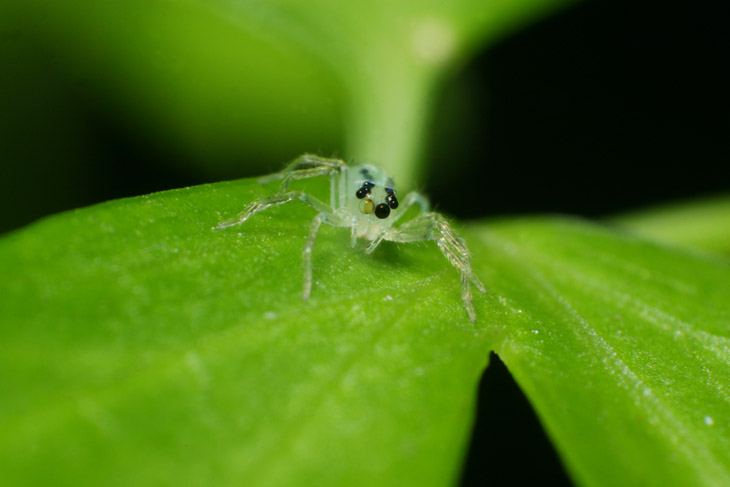
… while below is the tighter crop for detail.
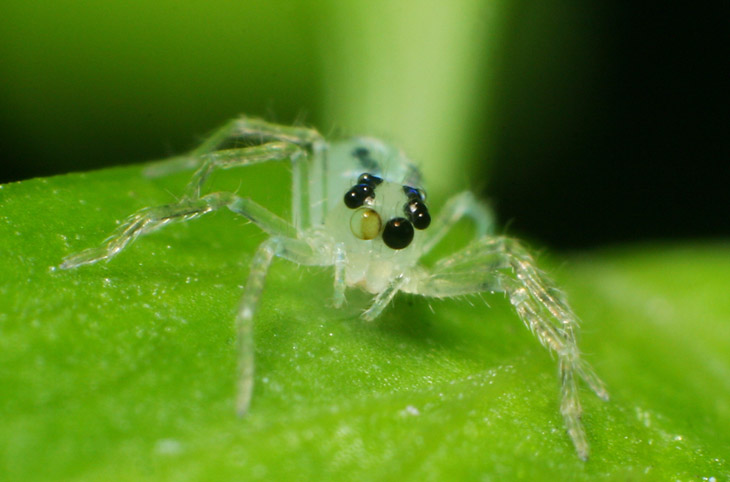
You’ll notice that the depth-of-field extends only as far back as the back of the ‘head’ (cephalothorax) – the abdomen is already well out of focus. We’ll see how short this range is in a moment. Of course, you can also see the wandering eyes that make this species so much fun to observe (you have seen the video, right?) and how big the secondary eyes are at this age, plus the absence of the ‘Lurch haircut.’
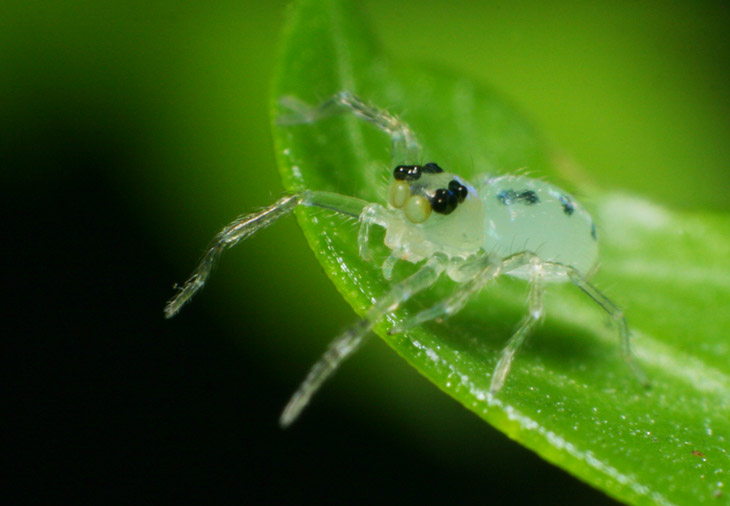
I took enough frames to ensure that I had at least a few that were sharp; this is not at all evident at the time, because the focal point is so small that a tiny twitch can render the spider fuzzy, and I’m not that perfectly steady when handholding the camera. Hell, even exhaling too hard can send the leaf swaying. The goal is to trip the shutter in the brief period that the spider has become as sharp as possible in the viewfinder, hoping that the minuscule delay in capture was not enough to twitch out of focus again, but also taking enough shots to increase the chances cumulatively.
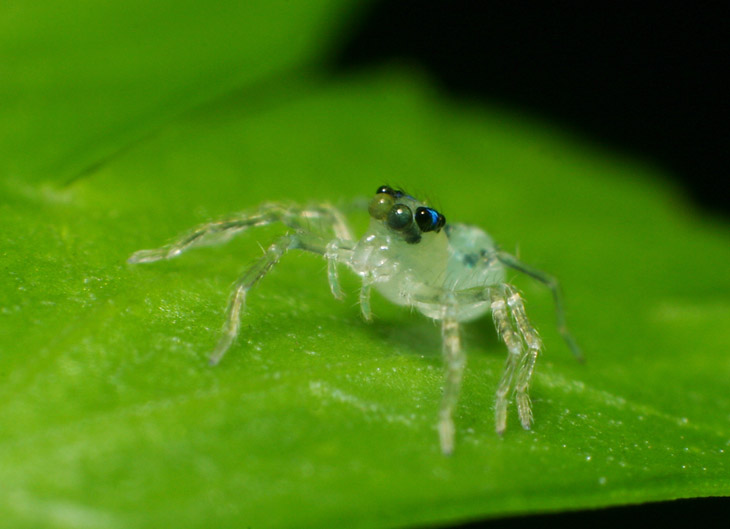
I had a minor advantage with a subject this size, too: she was small enough that the distance to the looming macro lens was too great for her to consider jumping across, something the larger specimens often didn’t hesitate to do. I’d either have to pull back sharply to thwart the impending jump, or stop and get them off the lens as they ran around avoiding me like an impish child in a shopping mall. In fact…
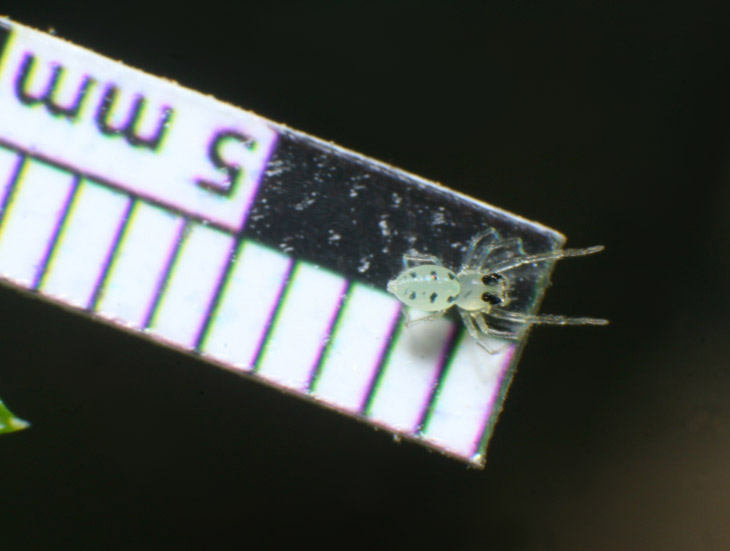
… here’s an actual scale shot, and the position indicates that the spider is about to jump – I’ve seen it enough times now to recognize the minute repositioning and the gathering of the legs, which you can see are evenly placed. You can see that the body length of the spider is perhaps just over 2mm, with the cephalothorax (and thus the depth-of-field) to be 1mm at best. So if you want to see what it’s like, try this: hold a pen in your teeth, and lean over a table without touching it and try to keep the point of the pen precisely at a particular millimeter marking on a ruler, without wavering a millimeter. That’s about comparable to focusing on such a small species, and reason enough why I try to lean against something steady whenever possible. Of course, if it’s the table that the subject sits upon, I can end up shaking it slightly even by breathing, and if it’s a parsley leaf on a slender stalk, this vibration gets magnified. Get the idea? Studio work is easier, but not exactly effortless.
[By the way, the chromatic aberration visible here on the rule, the green and magenta borders to the black lines, is not coming from my lens, but from the printer that produced the rules for me – they’re actually small Photoshop images tacked onto the border of my business card photos, that I fussed with in small increments until they reproduced at the right size. Photo prints, even meticulously-sized ones, are rarely printed at exact proportions, but enlarged slightly to overlap the edges enough to hide any registration errors, so even if I included a precise millimeter scale according to DPI and all that, they wouldn’t be accurate – I believe I’m sending them reduced by 3% to match up to the enlargement by the printer.]
But here’s another scale shot, perhaps a more illustrative one:
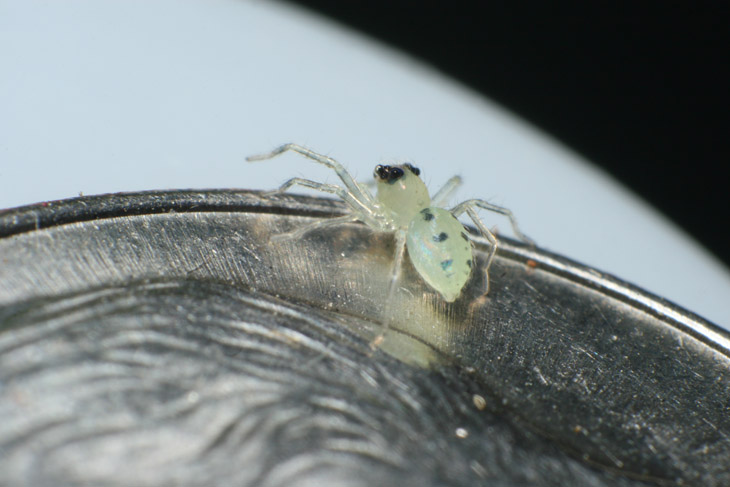
This was the first shot that I attempted, ruined when the spider took off and disappeared within the table, but successfully captured a little later on; the metal surface you are seeing here is a dime. Does that illustrate the size well enough?
And then, I made the mistake of slipping my subject here (the spider, not the dime) into the terrarium with the other two spiders and a half-dozen fruit flies. I have already seen the territoriality of the two occupants, which largely stay at opposite ends; the little addition didn’t even last an hour before I found her in the chelicerae of one of the larger ones. Worse, that one had just recently chowed down on a fruit fly, so this was either gluttony or spite. I attempted to get an image of this to follow through, but callous larger spider had perched onto the silk screen that serves as the ceiling and closure of the terrarium, which is only held on with a rubber band right now until I construct a new lid, so I couldn’t get a clear shot without disturbing her. Now, at least, I know not to introduce any more in with those two.
All of these shots save for the first, by the way, were done with the new reflector, no changes from that configuration. I’d say it’s working pretty well.




















































